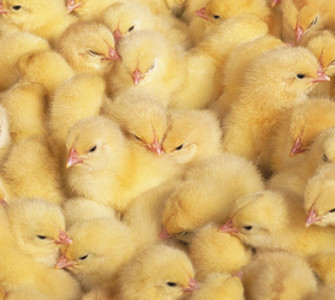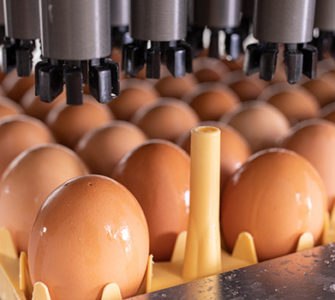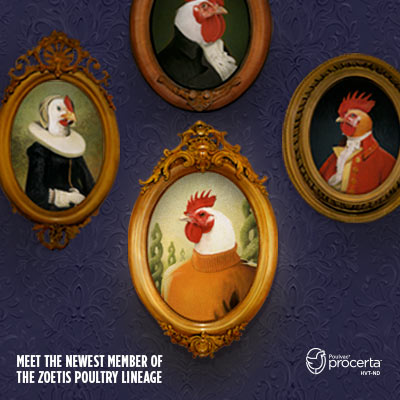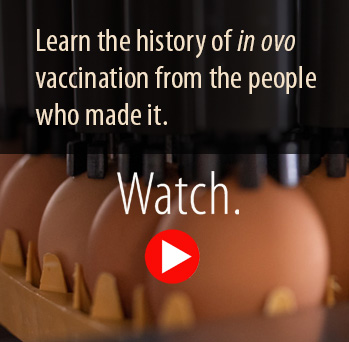Poulvac® Procerta™ HVT-ND provides advantages of a recombinant plus 19-day onset of immunity
Poulvac® Procerta™ HVT-ND provides producers with all the advantages of a recombinant vectored vaccine while protecting chickens against Newcastle and Marek’s diseases as early as 19 days of age,1 Sing Rong, PhD, research director, Zoetis, told Poultry Health Today.
Herpesvirus of turkey (HVT) is the base of the vaccine and provides the protection against Marek’s disease. It’s also known to be a good vector because it’s not virulent in the chicken, yet it provides life-long immunity. The vaccine vectors the Newcastle disease (ND) virus fusion (F) protein, which is the antigen that protects against ND.
HVT recombinant vectored vaccines are safe, and there is little interference from maternal antibodies. With live ND vaccines, there is concern about vaccine reactions, and maternal antibody interference is possible, said Rong, project team leader for development of the vaccine.
Key development factors
Several key factors are involved in the development of a good recombinant vaccine, Rong continued. One is selecting where the F protein will be inserted into the HVT genome. “Where you insert not only impacts the stability of the viruses, it impacts the efficacy so the insertion site is important,” she said.
Other important factors include selection of the best “expression cassette,” which is the F protein antigen sequence, the promoter that goes in front of the sequence to drive expression of the antigen and a poly A — a DNA sequence — at the end of the sequence.
“You want a strong promoter to have good antigen expression, but you don’t want it too strong,” Rong noted. If it’s too strong, that can lead to instability, so different promoters have to be tried to find the best one.
In the case of Poulvac Procerta HVT-ND, the Zoetis team of researchers put together different combinations of antigen sequences, insertion sites, promoters and poly A sequences. In fact, they constructed 13 different recombinants. All looked good and worked well in vitro, but the team set out to find the one that would provide the earliest protection, she said.
Achieving full protection
The final candidate was tested in two studies to confirm the onset of immunity, which was evaluated by both in ovo and subcutaneous routes of administration. Birds were challenged with a virulent ND strain, then observed for 14 days. If birds were alive at the end of the observation period, that showed the vaccine worked, Rong said.
Full protection — which requires at least 90% of birds to be protected — was provided by Poulvac Procerta HVT-ND by 19 days of age, but 75% of birds were protected as early as 17 days of age, she said.
Even though HVT-vectored vaccines are generally considered to be safe, the team confirmed the safety of Poulvac Procerta HVT-ND in field trials.2 “It’s very important to know what’s going on…not only in the lab setting — to test for efficacy and safety—but also to know in the field, under field conditions, that vaccines are safe for broilers.”
Since infectious bursal disease (IBD) is an important health concern in commercial poultry, two studies were conducted to make sure the new recombinant vaccine could be administered with a live IBD vaccine,3 Rong said. The IBD vaccine was Poulvac Bursaplex®, a classic, live, immune-complexed vaccine.
“So we [were] very pleased” with the results, she said. The studies provided confidence that if a producer combines those two vaccines, they should be able to achieve good efficacy.
1 Data on file. Study no. B815R-US-18-A46, Zoetis LLC.
2 Data on file. Study nos B911R-US-18-902, B911R-US-18-903, B911R-US-18-904, and B911R-US-18-906, Zoetis LLC.
3 Turner-Alston K, et al. Compatibility of a Recombinant HVT-ND Vaccine with Bursaplex to Provide Protection against Velogenic NDV and Virulent Classic IBDV Challenge in SPF Birds. Am Assoc Avian Pathol. 2019.
All trademarks are the property of Zoetis Services LLC or a related company or a licensor unless otherwise noted. ©2020 Zoetis Services LLC. All rights reserved.
BIO-00254
Posted on November 2, 2020















